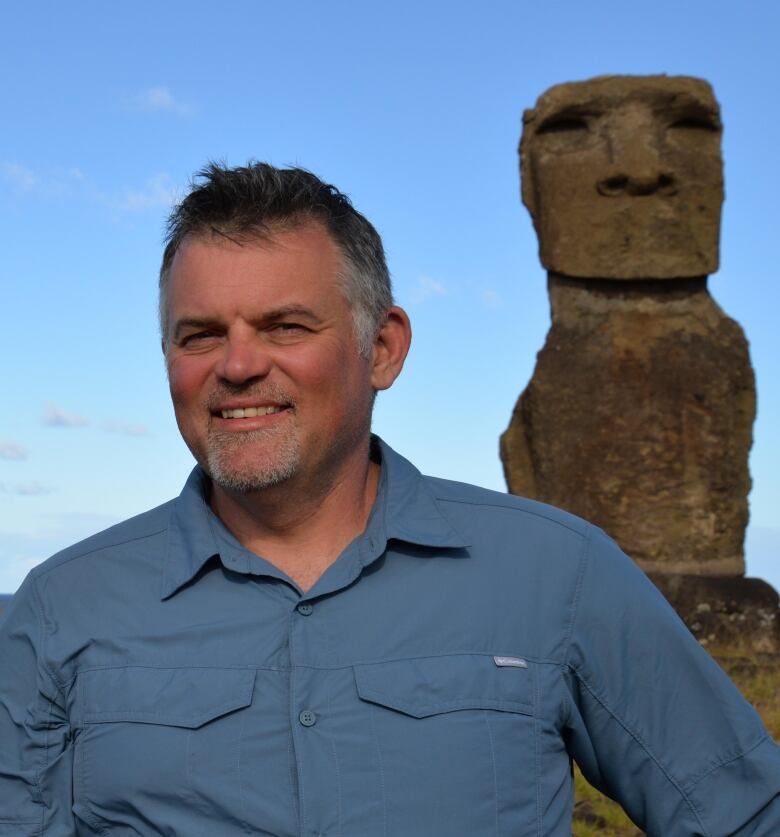Researchers finally know how Easter Island statues got their hats
'Adding a hat on top was outdoing your neighbour,' said Carl Lipo

The Easter Island statues, or moai, are multi-tonne enigmas.
So are their hats.
The 'how' and the 'why' of these stone accessories, called pukao, weighed on Binghamton University archeology professor Carl Lipo. So much so that he went to Easter Island with a team of researchers seeking answers.
The statues themselves are mysterious enough. Having been built an estimated 700 or so years ago, there are centuries worth of speculation and theories about how the Rapa Nui people were able to erect and relocate the structures.

"It's hard enough to explain how they moved these giant statues that were the size of buildings, much less putting big hats on top of them that weighed as much as several tonnes," Lipo told As It Happens host Carol Off.
The simple answer is that the hats were built as part of the original moai, but alas.
Adding a hat on top was outdoing your neighbour.- Carl Lipo, archeologist
"The statues for the most part were made out of a certain kind of stone that comes from a very specific quarry known as Rano Raraku. The hats themselves are actually made of a different stone — a red scoria material — that's carved from a different quarry that sits on the other side of the island," Lipo explained.
"So they definitely were carved in a separate effort."
The art of the parbuckle
Getting the colossal hats onto the equally colossal heads of the moai required more technique than heavy-lifting.
Lipo and his team made 3-D model replicas of the statues and their hats to examine the 'how'.
The researchers landed on parbuckling as the most likely method of the hat-raising.

"The way they did that was constructing giant ramps and rolling them upward using what's called a parbuckling technique. The parbuckling technique involves using rope … and wrapping it around the centre of the wheel (hat) and basically pulling the pukao up the ramp in an uphill fashion," Lipo said.
He said it helps to picture yanking an enormous yo-yo up a hill by its string.
That might be how it was done. But why?
Size matters
"You might think: 'well why would anybody do that on this tiny island that's so remote and isolated?'" Lipo said.
"There's a number of parts of that answer."
He explained that these statues represent their ancestors, and the hats are an adornment on the figures that watch over the community and keep everyone safe.

"The other part of the answer is that doing this action, which required people to get together, brought the community together to share resources and information. On this island which is really remote and very tiny, sharing resources is going to be really important," he said.
"So the action of making statues and putting hats on them and doing all the things related to statues actually strengthened the community and made them very successful."
Lipo's research suggests that the hats weren't part of the original statues, but were added later as communities looked upon one another's work.
"They started to compete with one another to make bigger and bigger statues and adding a hat on top was outdoing your neighbour, and adding additional excess effort to show how strong that community was relative to other communities," he said.

Turning a theory on its head
People continue to wonder about what happened to the Rapa Nui people who put so much into creating these statues. There are theories that de-forestation from acquiring statue-building resources led to the population's decline.

What Lipo believes, based on decades of research, is quite the opposite.
The archeologist hypothesizes that building the statues saved the Rapa Nui people.
"Making these statues, putting hats on top of them, really was essential to the survival of the people on the island," Lipo said.
"This was the mechanism that actually made them successful because it brought the community together, it forged a community where they shared resources and saw identity with each other when times were tough."
Written and produced by Emilie Quesnel.